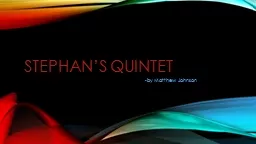/


by Matthew Johnson Overview Why I chose Stephans Quintet Information about the Quintet How I obtained the images Final Image Why I chose this object Stephans quintet Édouard ID: 378331
Download Presentation The PPT/PDF document "Stephan’s quintet" is the property of its rightful owner. Permission is granted to download and print the materials on this web site for personal, non-commercial use only, and to display it on your personal computer provided you do not modify the materials and that you retain all copyright notices contained in the materials. By downloading content from our website, you accept the terms of this agreement.
Slide1
Stephan’s quintet
-by Matthew JohnsonSlide2
Overview
Why I chose Stephan’s Quintet
Information about the Quintet
How I obtained the images
Final ImageSlide3
Why I chose this objectSlide4
Stephan’s quintet
Édouard
Stephan discovered his “quintet” in 1877 at the Marseille Observatory
Located in the constellation Pegasus
About 210-340 million light years from Earth (although NGC 7320 is ~40 million
ly
)
The molecular hydrogen seen
in the starburst region is one of the most turbulent forms of molecular hydrogen ever seen. Slide5
Stephan’s quintet
One of the fastest moving objects in the observable universe is a galactic shock wave (green) moving at several hundred million miles per hour.
This phenomenon is caused by the galaxy NGC 7318B (just to the right of the green gas)
The largest amount of molecular hydrogen ever observedSlide6
Stephan’s Quintet
This
unusual system has often been used as proof that the redshift is not truly a distance
indicator
Four
of the galaxies have similar, large redshifts, the fifth (NGC7320),
shows
a much smaller redshift.
Conventional
theory states that the low-redshift galaxy is in a nearby group and by coincidence appears on the sky projected against a distant background group. Slide7
Taking images
20”
Cassegrain
Telescope
STL
CCD-1001E
RGB Filters
20-3 minute clear images
10-3 minute
RGBI chose to use RGB filters instead of narrowband because the galaxies are so far away and so faint. If I were to use narrowband it would not bring forth much more detail than I already have.Slide8
Taking images
Night 1:
Start Time: 1730 (5:30 pm)
End Time: ~0030 (12:30 am)
Never used the 20” by myself, so mainly a learning night
Result: 20 Clear ImagesSlide9
Taking images continued…
Night 2:
Start Time: 1700 (5:00pm)
End Time: 0030 (12:30am)
Mirrors were off. Took about an hour to fix, we got lucky!
After that we fix mirrors, CLOUDS!!
I wait an hour or so……MORE CLOUDS!!
Result: No usable dataSlide10
Taking Images continued…
Night 3:
Start Time: 1730 (5:30 pm)
End Time: ~2100 (9:00 pm)
Started out as a perfect night, temperature in the upper 60s, no wind…lets image!!
Then this happened:
Around 8:30 the temperature dropped 30 degrees in less than 5 minutes followed by what felt like 60 mph winds
Result: No usable data!Slide11
Taking images continued…
Night 4:
Start Time: 1730 (5:30 pm)
End Time: 0130 (1:30 am)
Clear..
ish
Mild wind
20 degrees!
Result: 10 RGB images of each filter! Slide12
Final image!
With close to 40 hours of attempted imaging
-Freezing weather
-Tornado like winds
-Equipment malfunctions
S
everal hours of trial and error with Photoshop! -Reduce -Align -Combine Slide13
NGC 7320
NGC 7318B
NGC 7318A
NGC 7317
NGC 7319Slide14
Referenceshttp://www.phys.ttu.edu/~
maurice/gott06.jpg
http://
th00.deviantart.net/fs33/PRE/i/2008/239/6/5/Cloudy_Night_Sky_by_RamosBurrito.jpg
http://
en.wikipedia.org/wiki/Stephan%27s_Quintet
http://
under30ceo.com/wp-content/uploads/2014/08/Success.jpg
http://
apod.nasa.gov/apod/ap140327.htmlhttp://www.noao.edu/image_gallery/html/im0414.htmlSlide15
Questions?